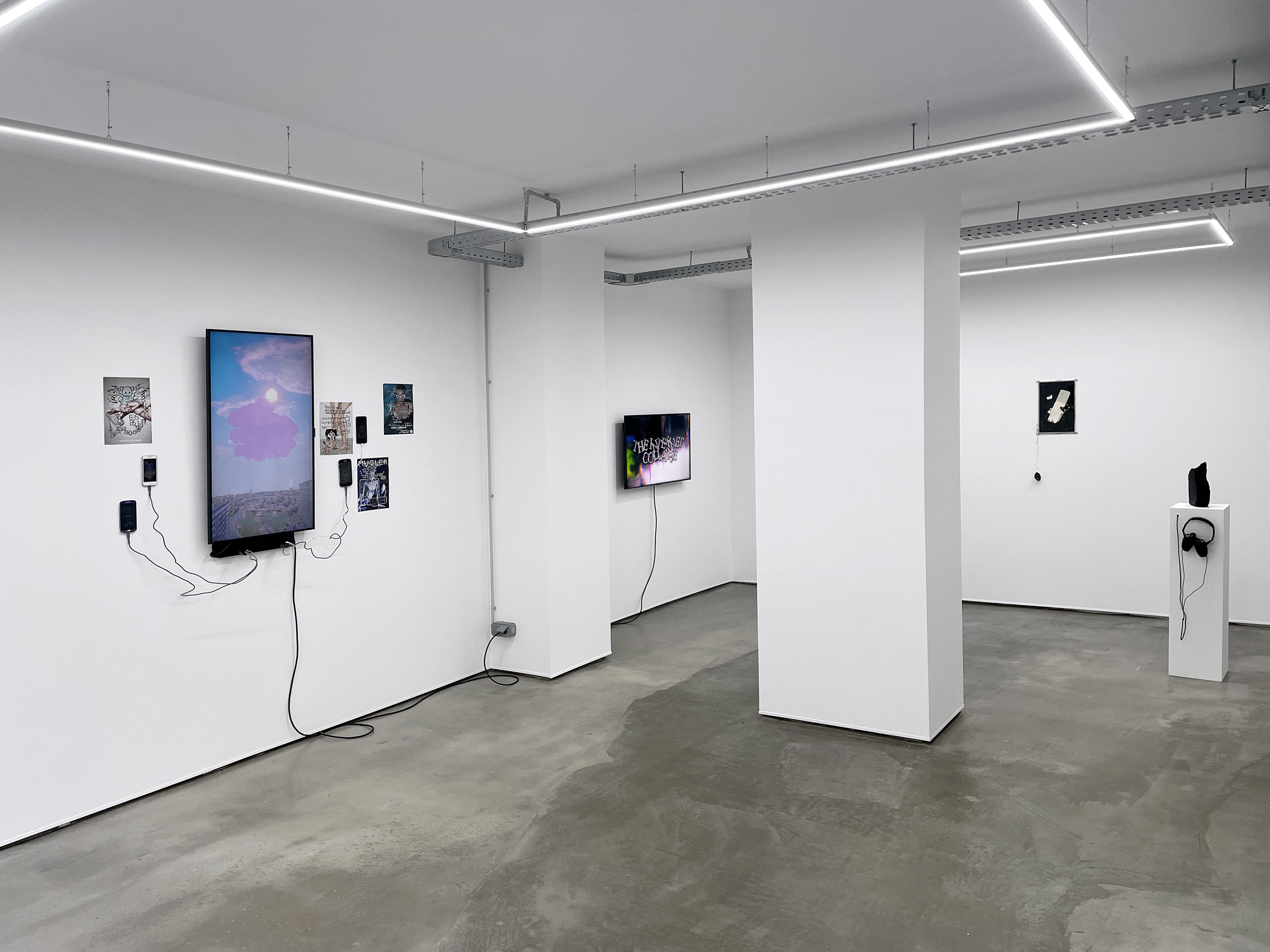 POV: you’re upset because it’s the end of the world and you’re stuck between realities, 2023
POV: you’re upset because it’s the end of the world and you’re stuck between realities, 2023Exo Exo, Paris
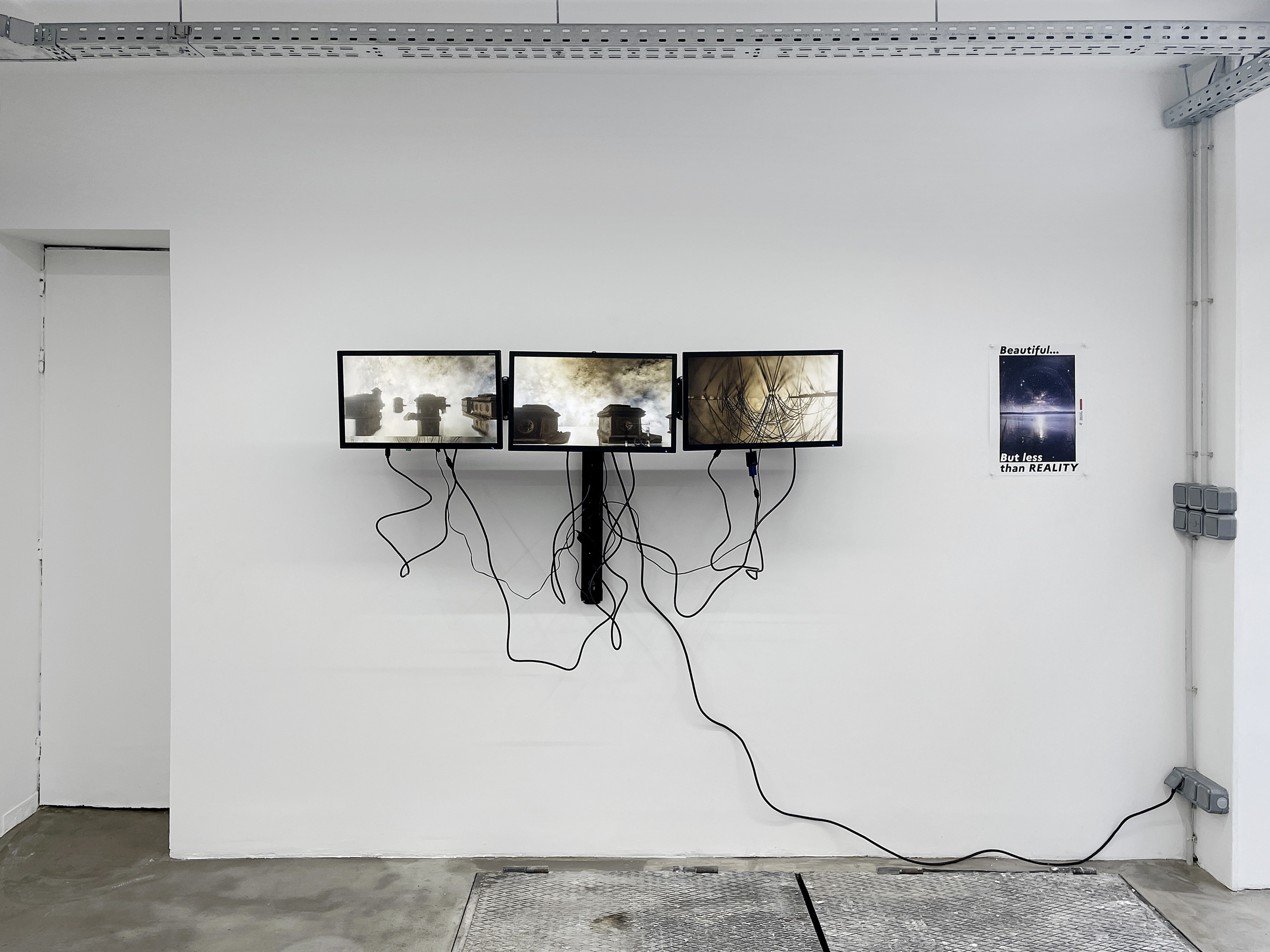 POV: you’re upset because it’s the end of the world and you’re stuck between realities, 2023
POV: you’re upset because it’s the end of the world and you’re stuck between realities, 2023Exo Exo, Paris
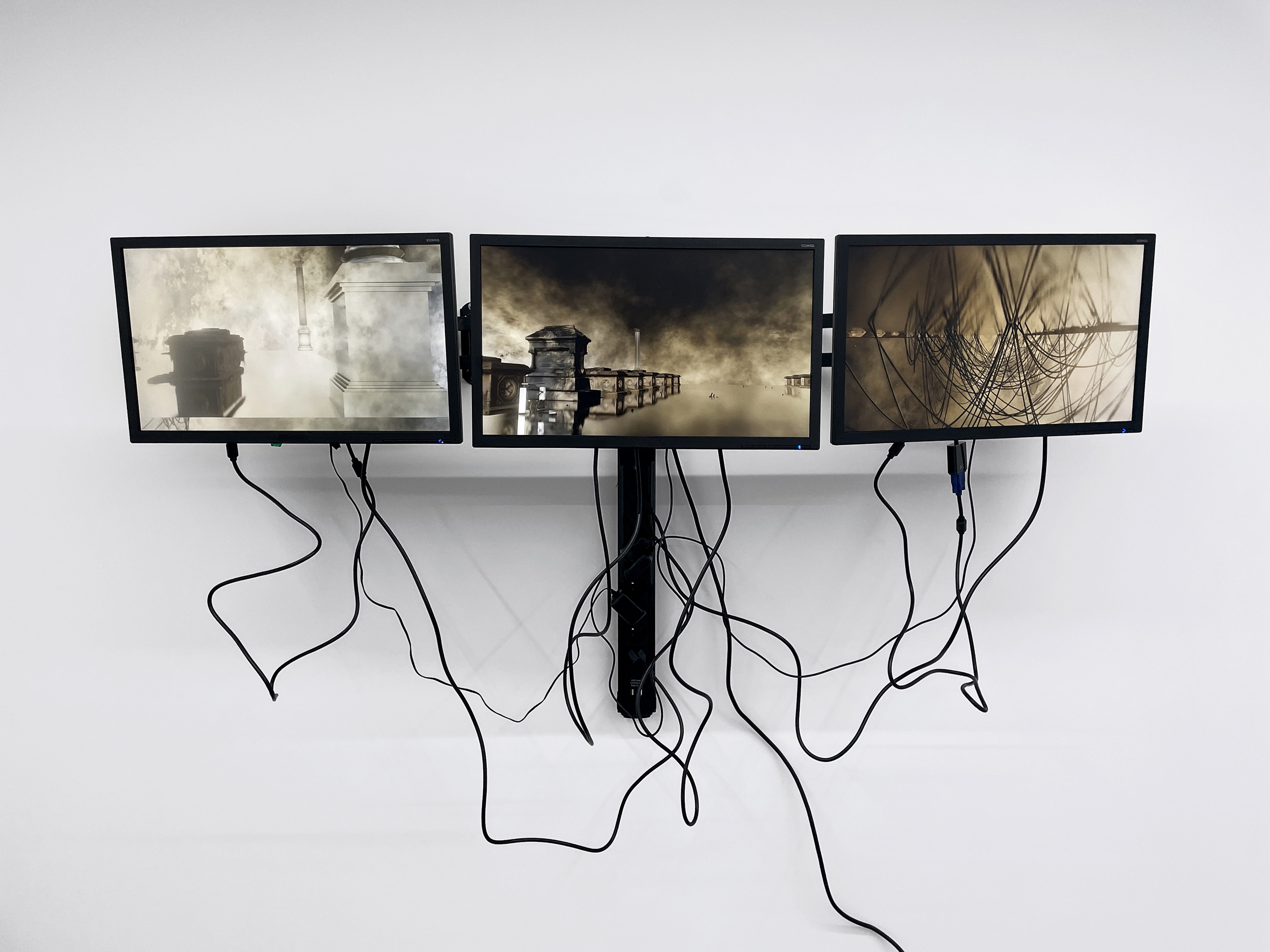 Lou Fauroux, The World Wide Surveillance Board series, The SpaceX cemetery, 2023
Lou Fauroux, The World Wide Surveillance Board series, The SpaceX cemetery, 20233D rendered color video animation, monitors, TV mounts, video cables
Dimensions variables
Inquire
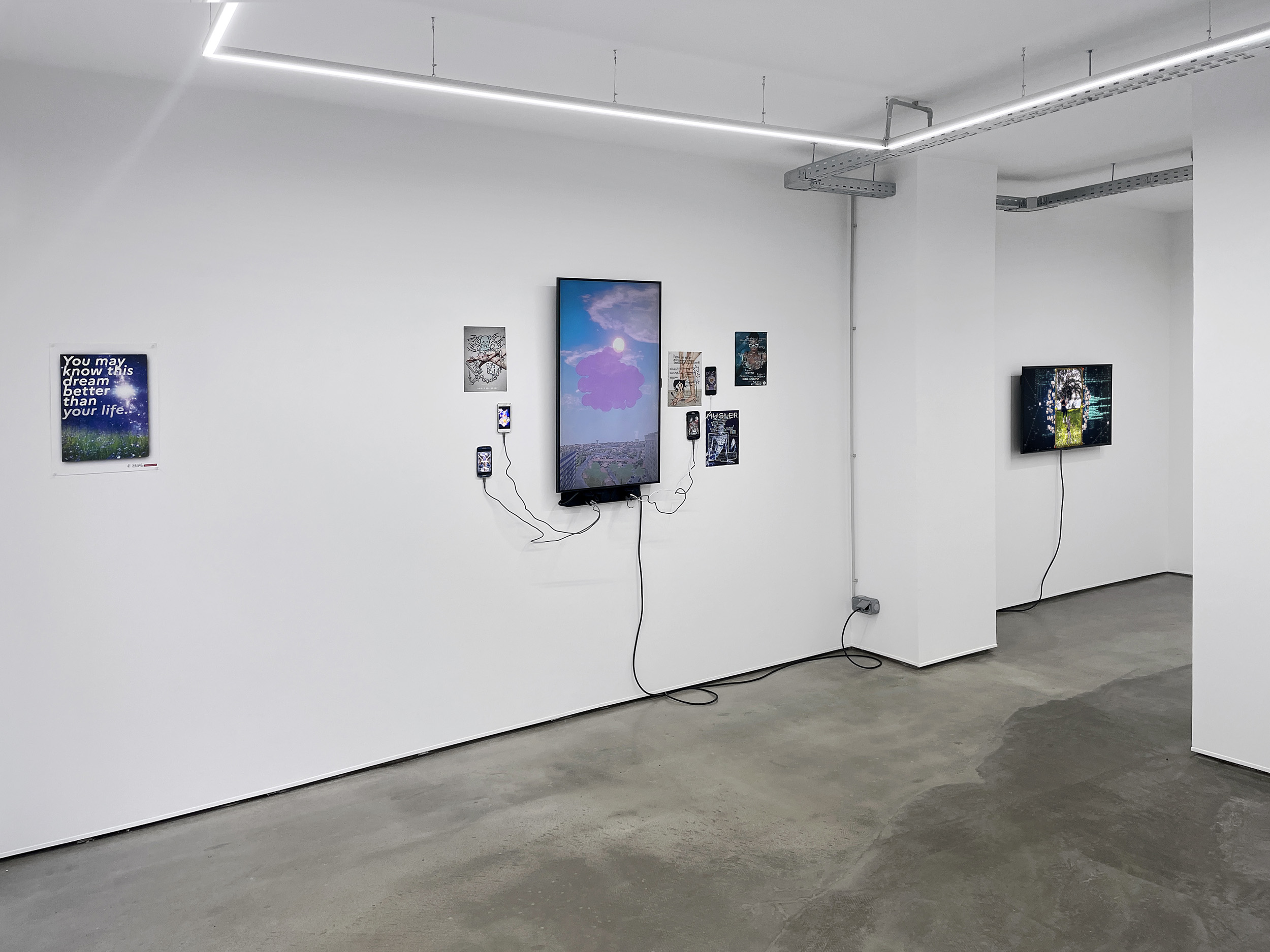 POV: you’re upset because it’s the end of the world and you’re stuck between realities, 2023
POV: you’re upset because it’s the end of the world and you’re stuck between realities, 2023Exo Exo, Paris
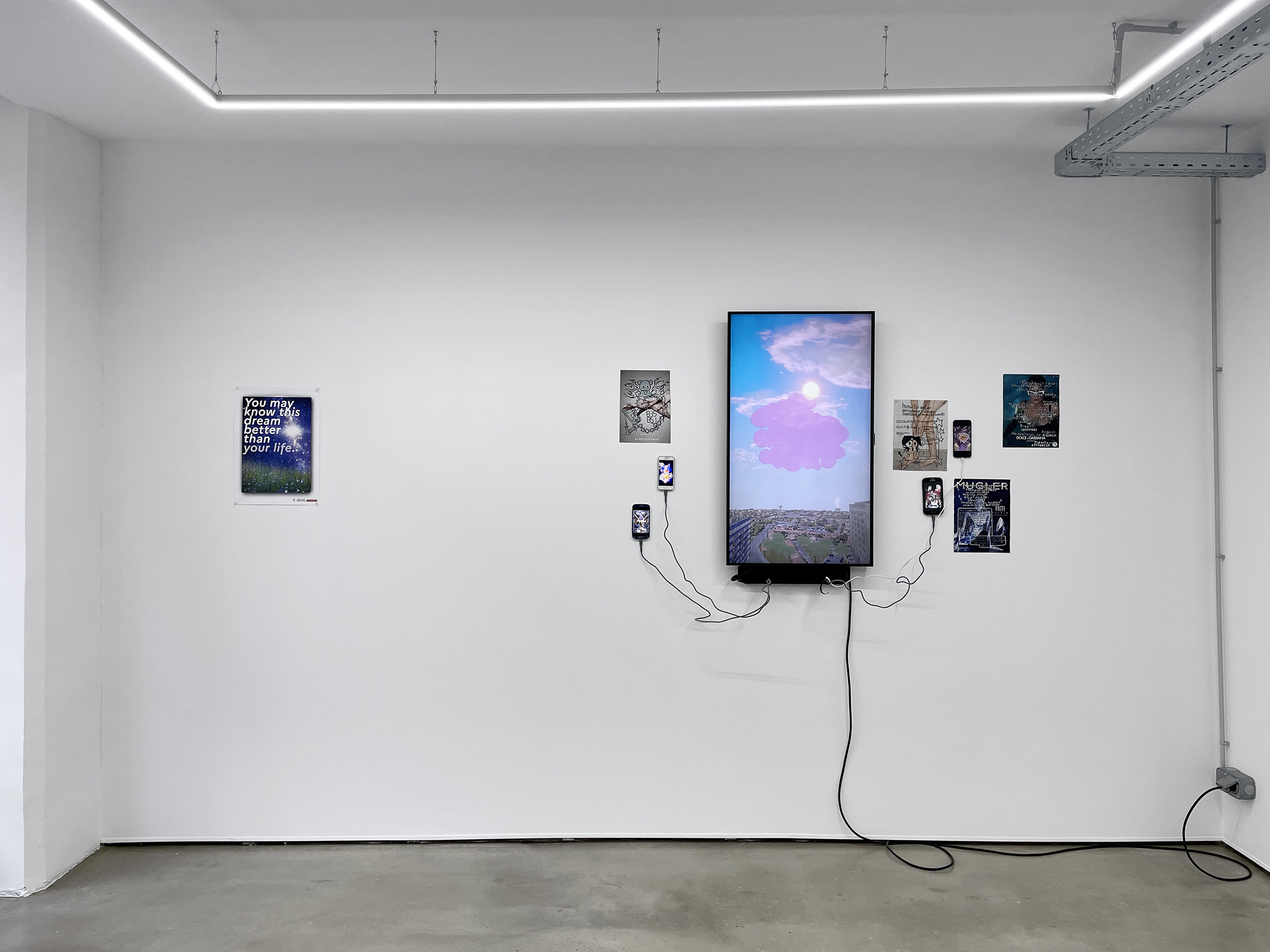 POV: you’re upset because it’s the end of the world and you’re stuck between realities, 2023
POV: you’re upset because it’s the end of the world and you’re stuck between realities, 2023Exo Exo, Paris
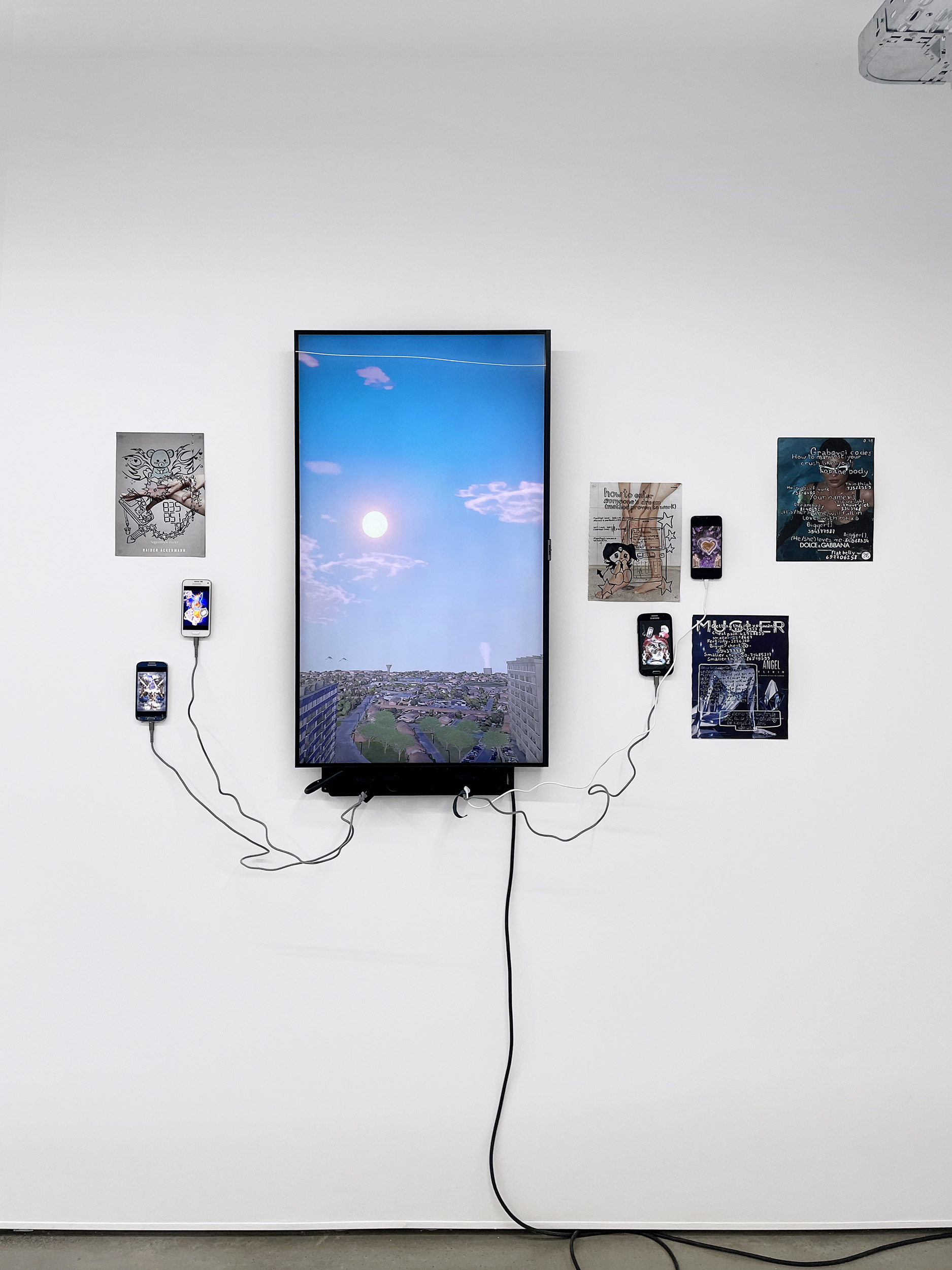 Montaine Jean, Dreams&Hopes, 2023
Montaine Jean, Dreams&Hopes, 20233D video 16:9 directed with Louis David (10 min loop), telephones, printed images, marker on magazine paper
Dimensions variables
Inquire
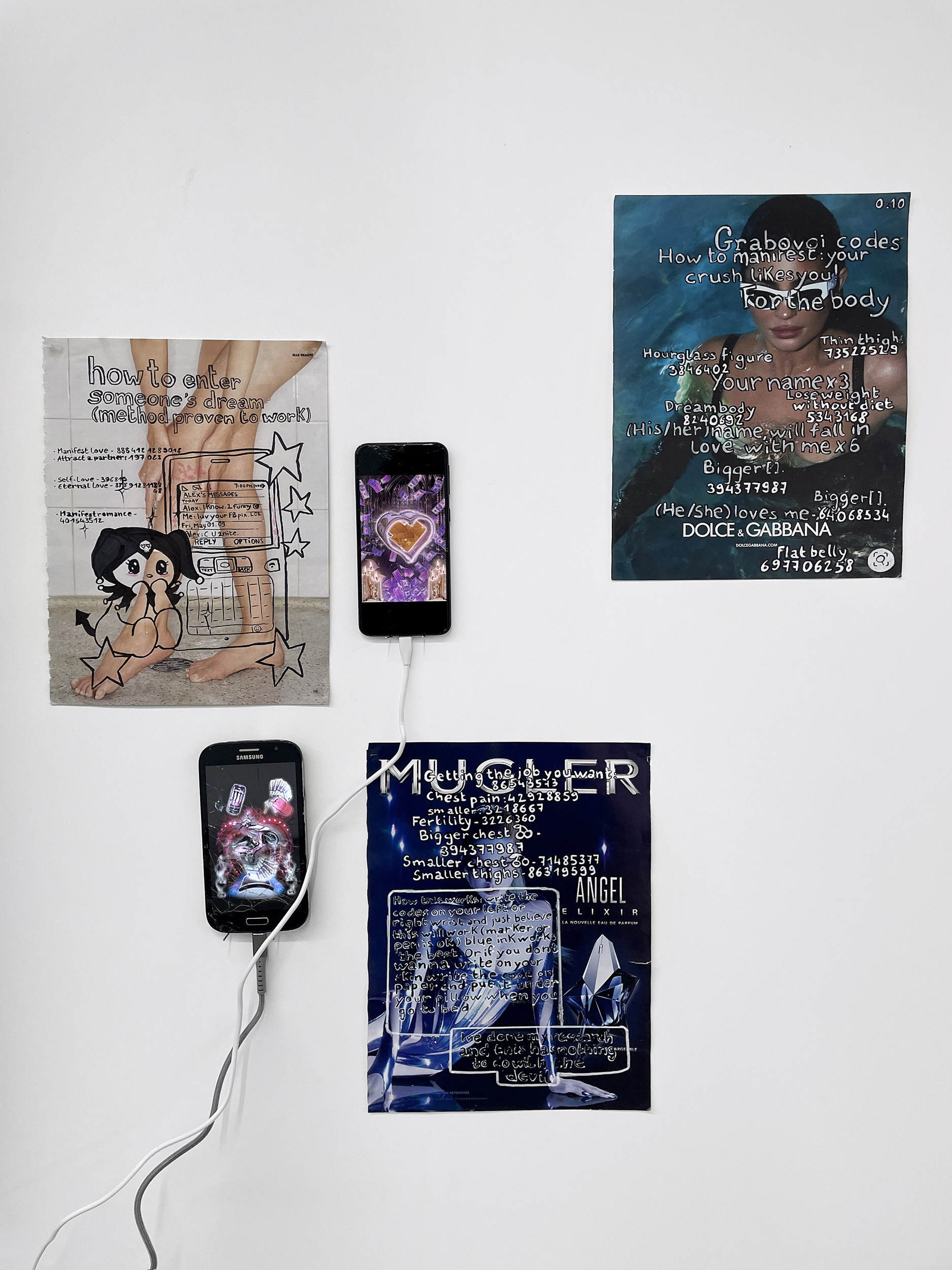 Montaine Jean, Dreams&Hopes, detail, 2023
Montaine Jean, Dreams&Hopes, detail, 20233D video 16:9 directed with Louis David (10 min loop), telephones, printed images, marker on magazine paper
Dimensions variables
Inquire
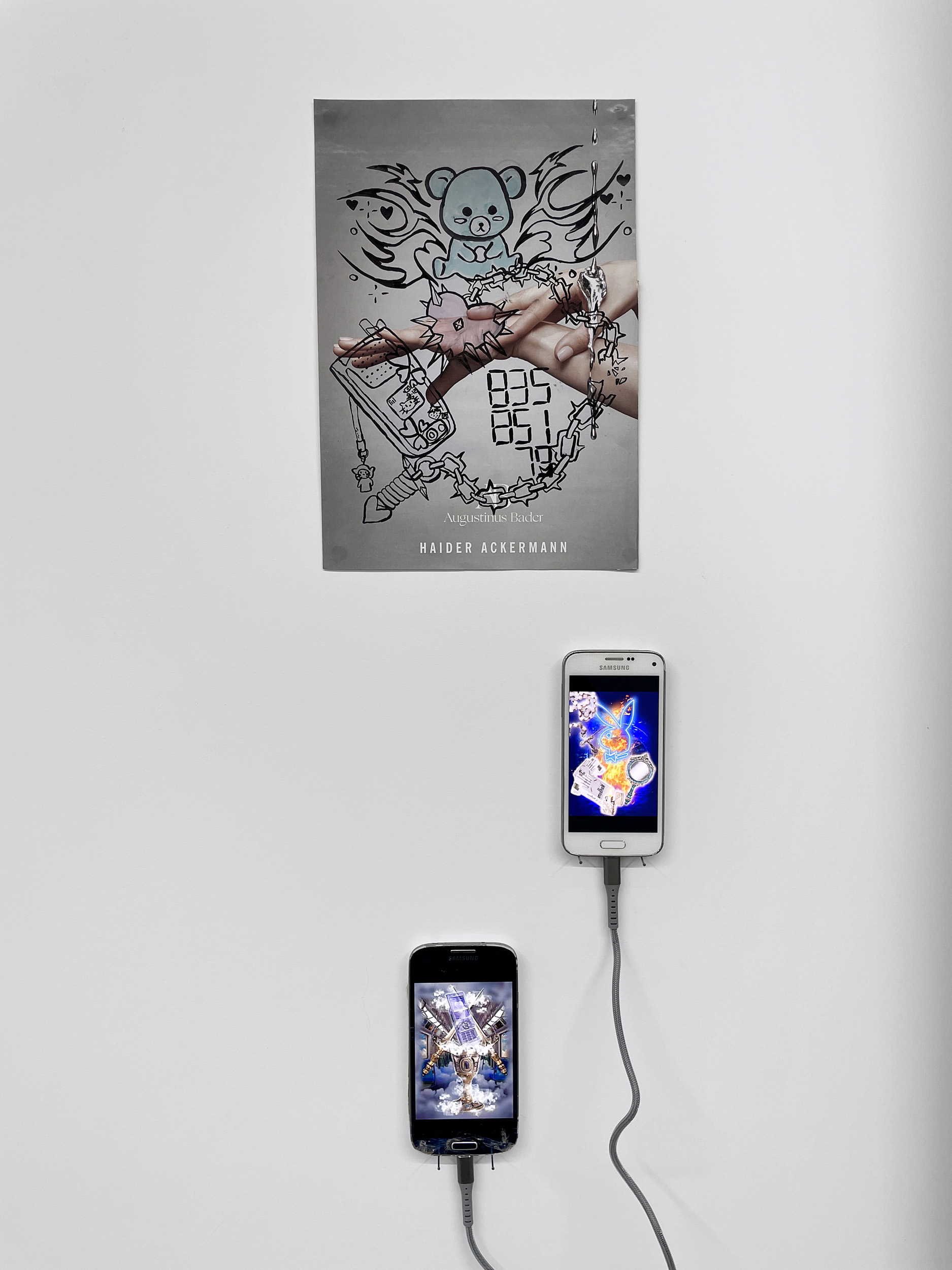 Montaine Jean, Dreams&Hopes, detail, 2023
Montaine Jean, Dreams&Hopes, detail, 20233D video 16:9 directed with Louis David (10 min loop), telephones, printed images, marker on magazine paper
Dimensions variables
Inquire
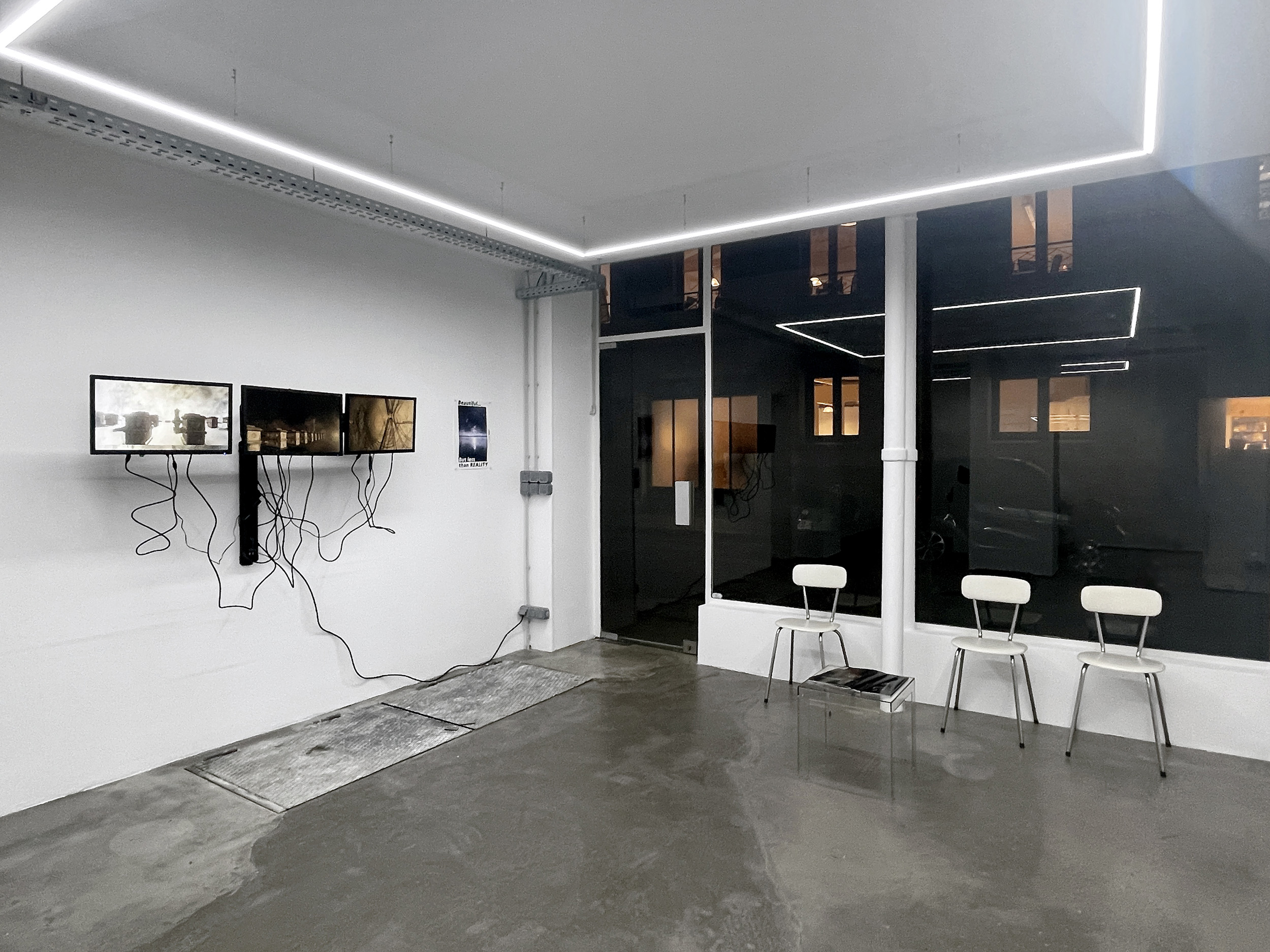 POV: you’re upset because it’s the end of the world and you’re stuck between realities, 2023
POV: you’re upset because it’s the end of the world and you’re stuck between realities, 2023Exo Exo, Paris
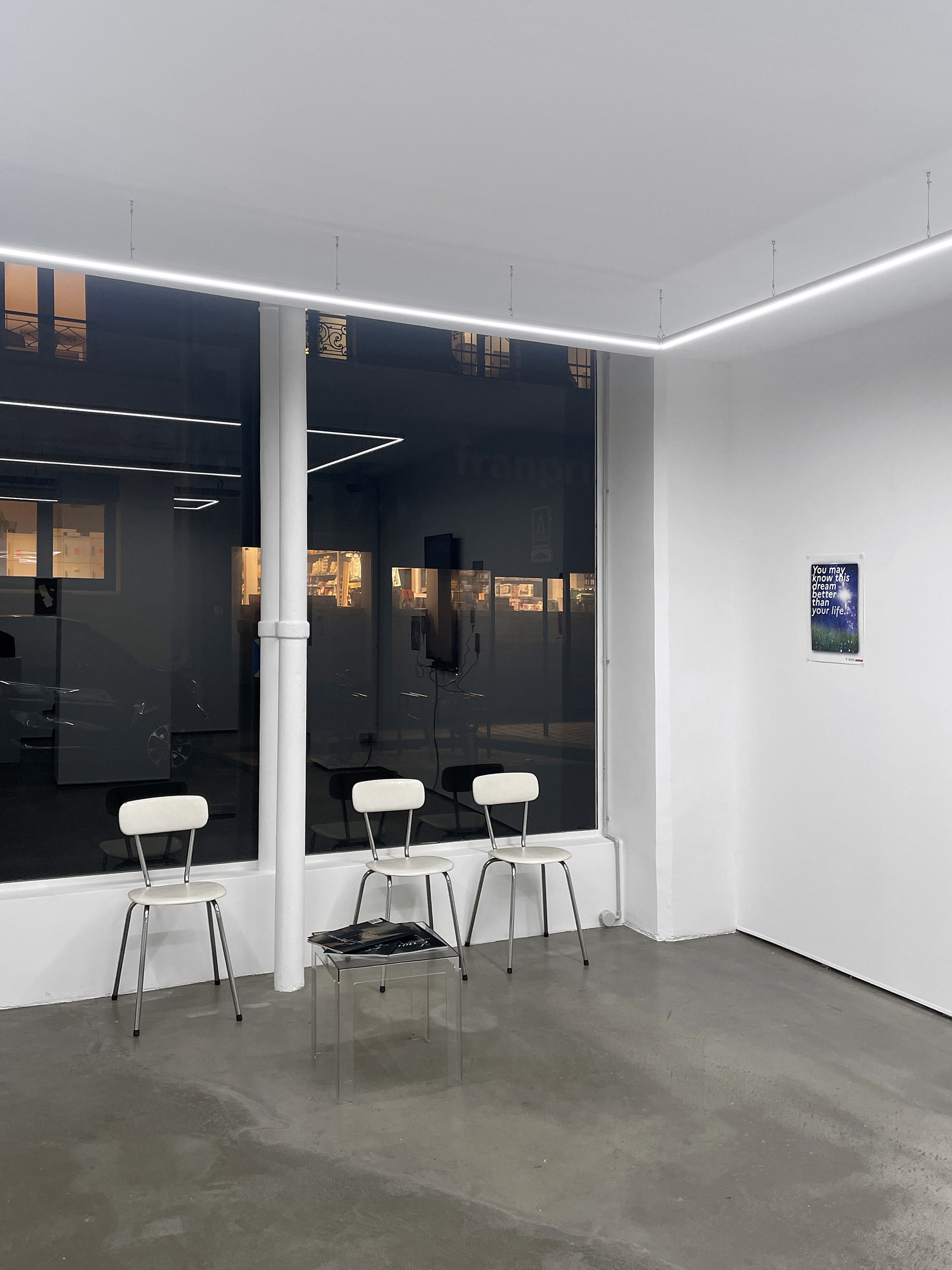 POV: you’re upset because it’s the end of the world and you’re stuck between realities, 2023
POV: you’re upset because it’s the end of the world and you’re stuck between realities, 2023Exo Exo, Paris
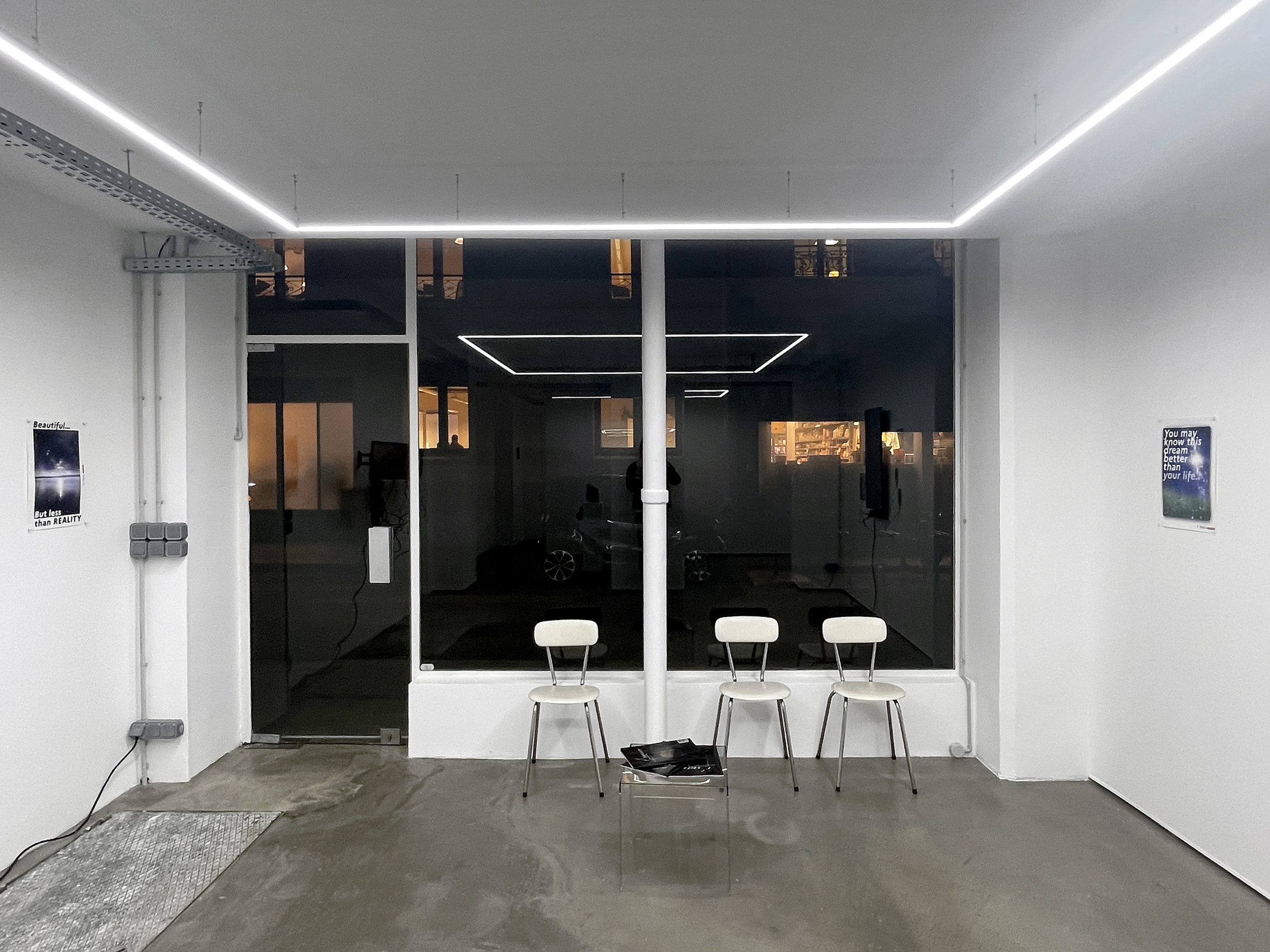 Jeanne Yuna Rocher, Errance (Errance magazine), 2023
Jeanne Yuna Rocher, Errance (Errance magazine), 2023Square fold glossy 64-page magazines, printed A4 posters, chairs, coffee table
Dimensions variables
Inquire
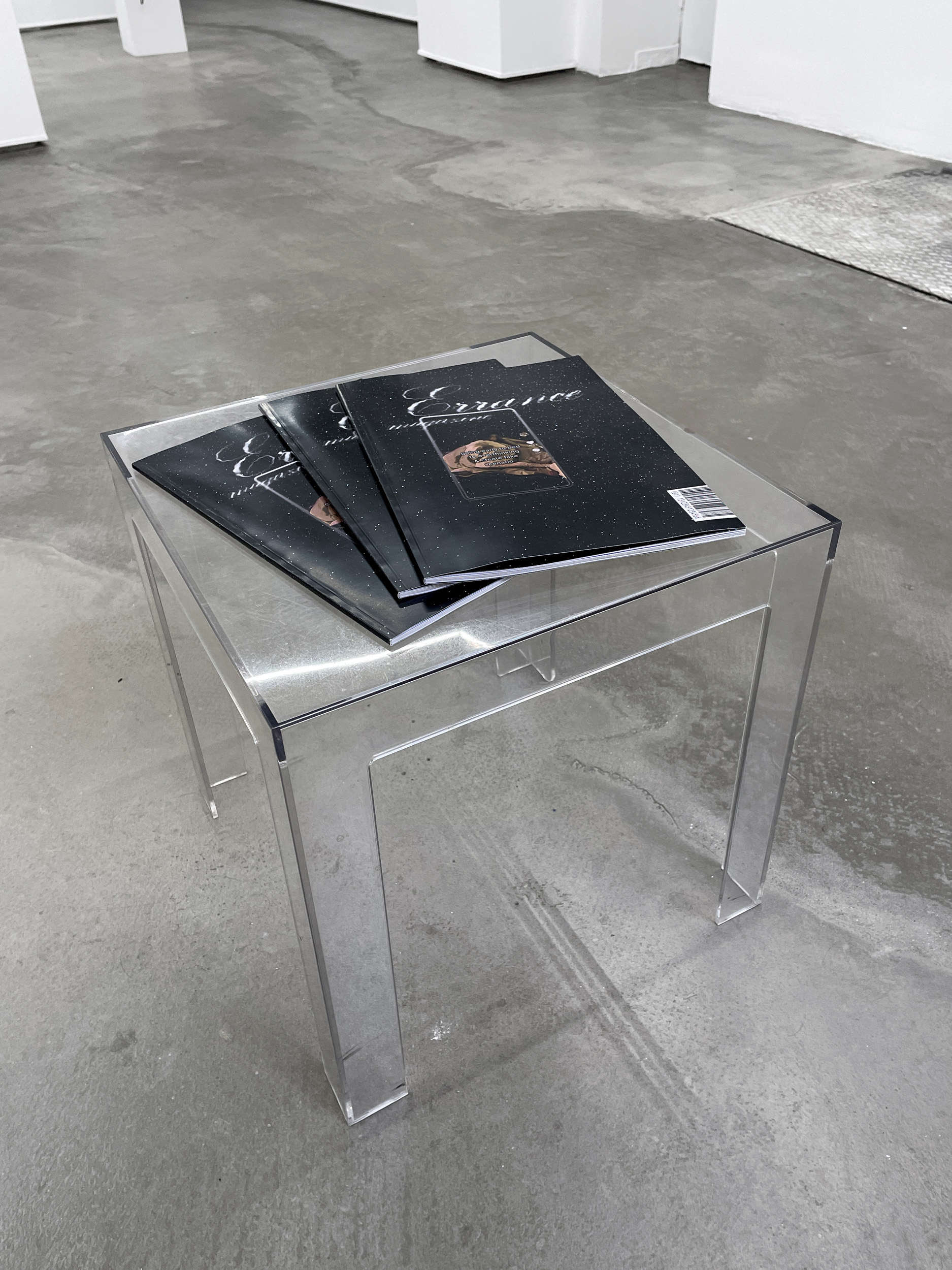 Jeanne Yuna Rocher, Errance (Errance magazine), detail, 2023
Jeanne Yuna Rocher, Errance (Errance magazine), detail, 2023Square fold glossy 64-page magazines, printed A4 posters, chairs, coffee table
Dimensions variables
Inquire
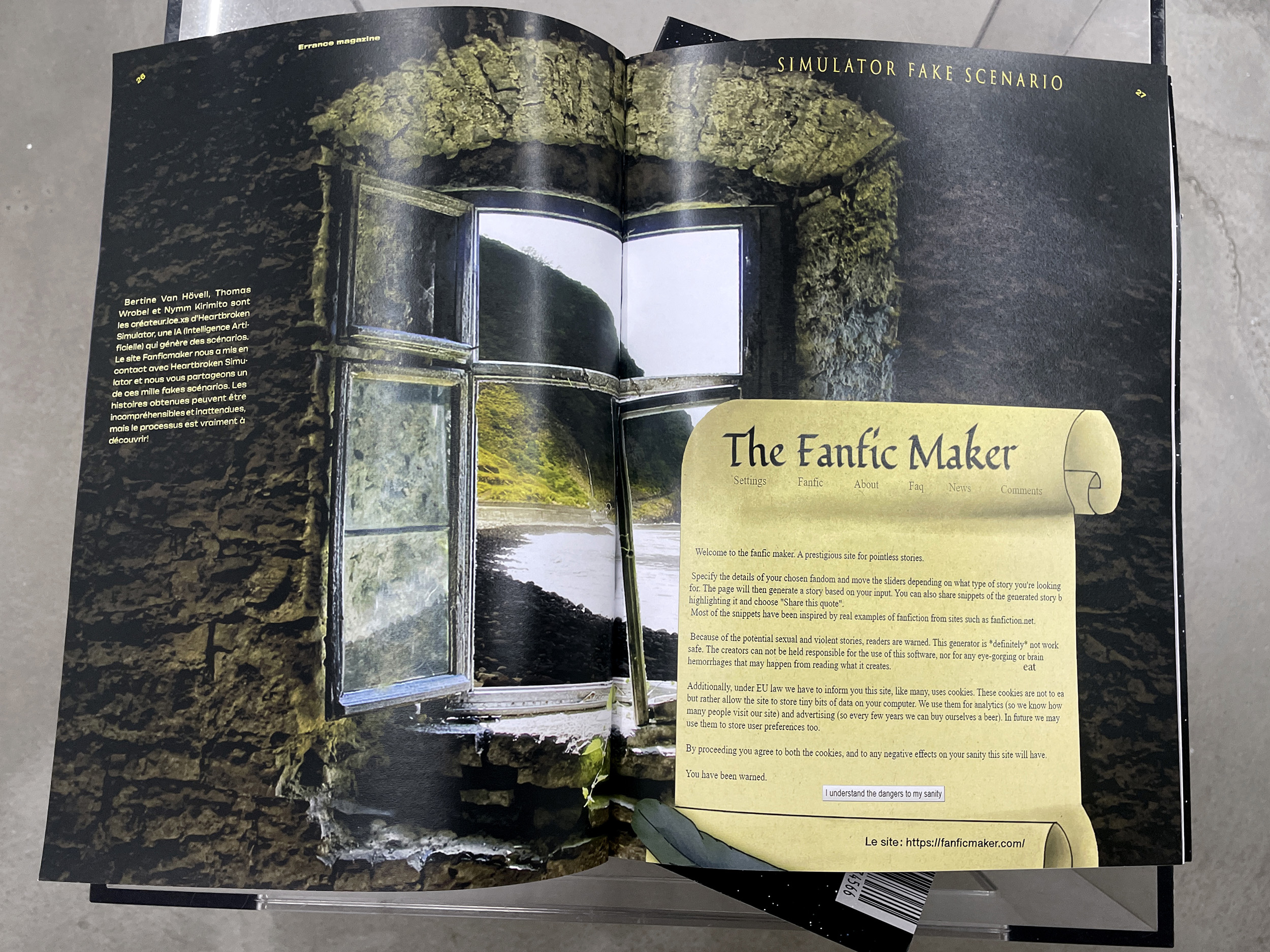 Jeanne Yuna Rocher, Errance (Errance magazine), detail, 2023
Jeanne Yuna Rocher, Errance (Errance magazine), detail, 2023Square fold glossy 64-page magazines, printed A4 posters, chairs, coffee table
Dimensions variables
Inquire
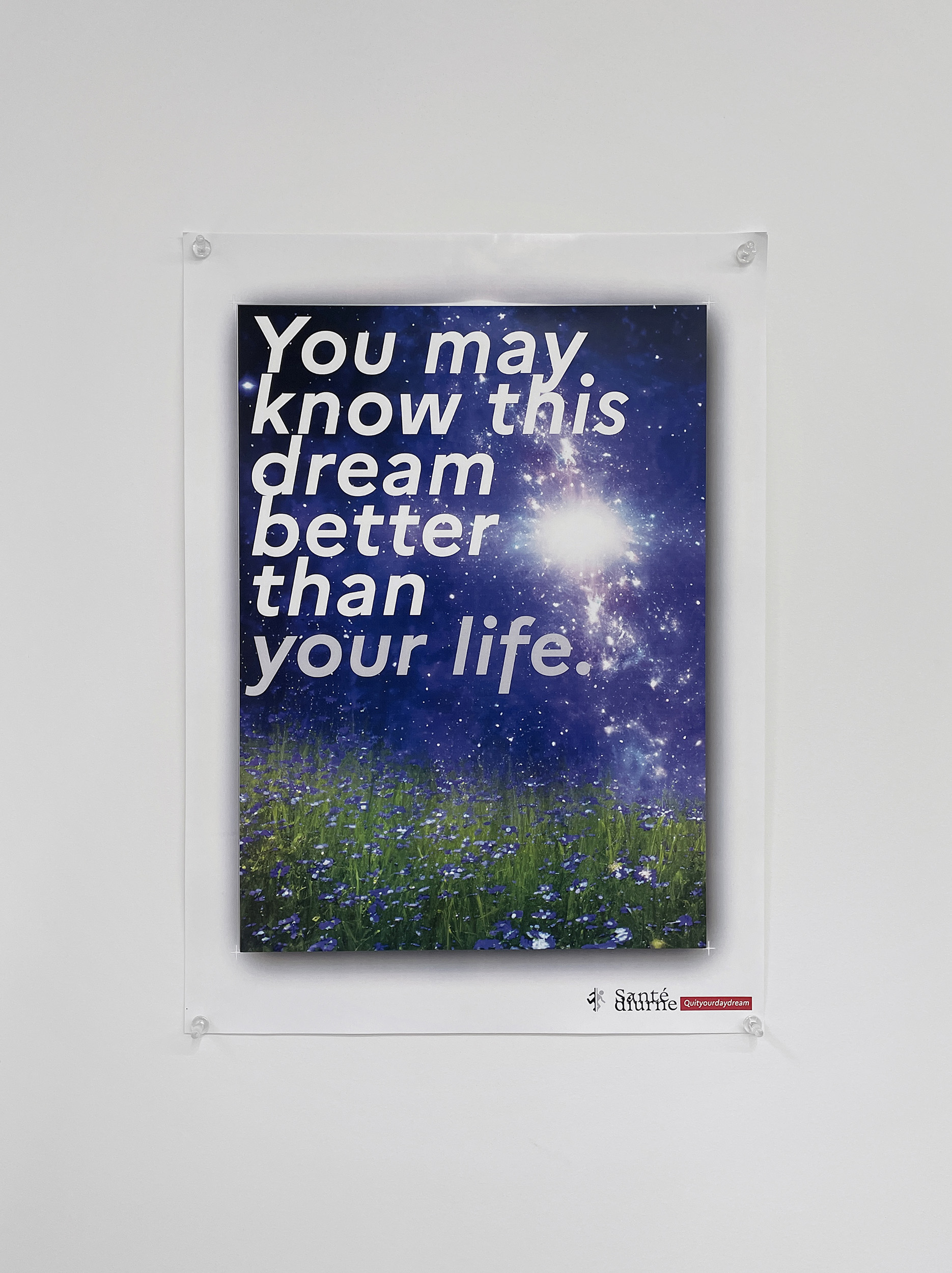 Jeanne Yuna Rocher, Errance (Errance magazine), detail, 2023
Jeanne Yuna Rocher, Errance (Errance magazine), detail, 2023Square fold glossy 64-page magazines, printed A4 posters, chairs, coffee table
Dimensions variables
Inquire
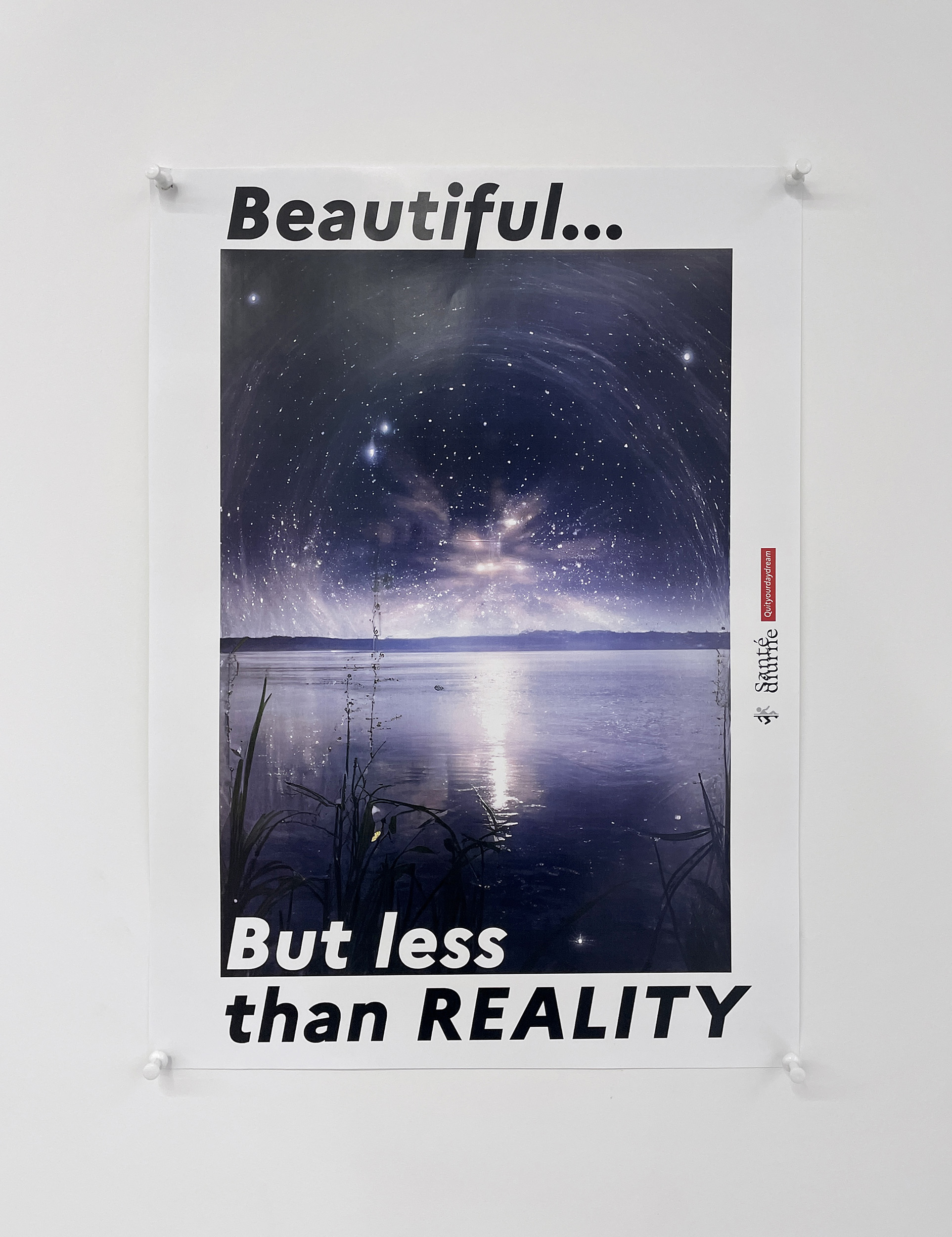 Jeanne Yuna Rocher, Errance (Errance magazine), detail, 2023
Jeanne Yuna Rocher, Errance (Errance magazine), detail, 2023Square fold glossy 64-page magazines, printed A4 posters, chairs, coffee table
Dimensions variables
Inquire
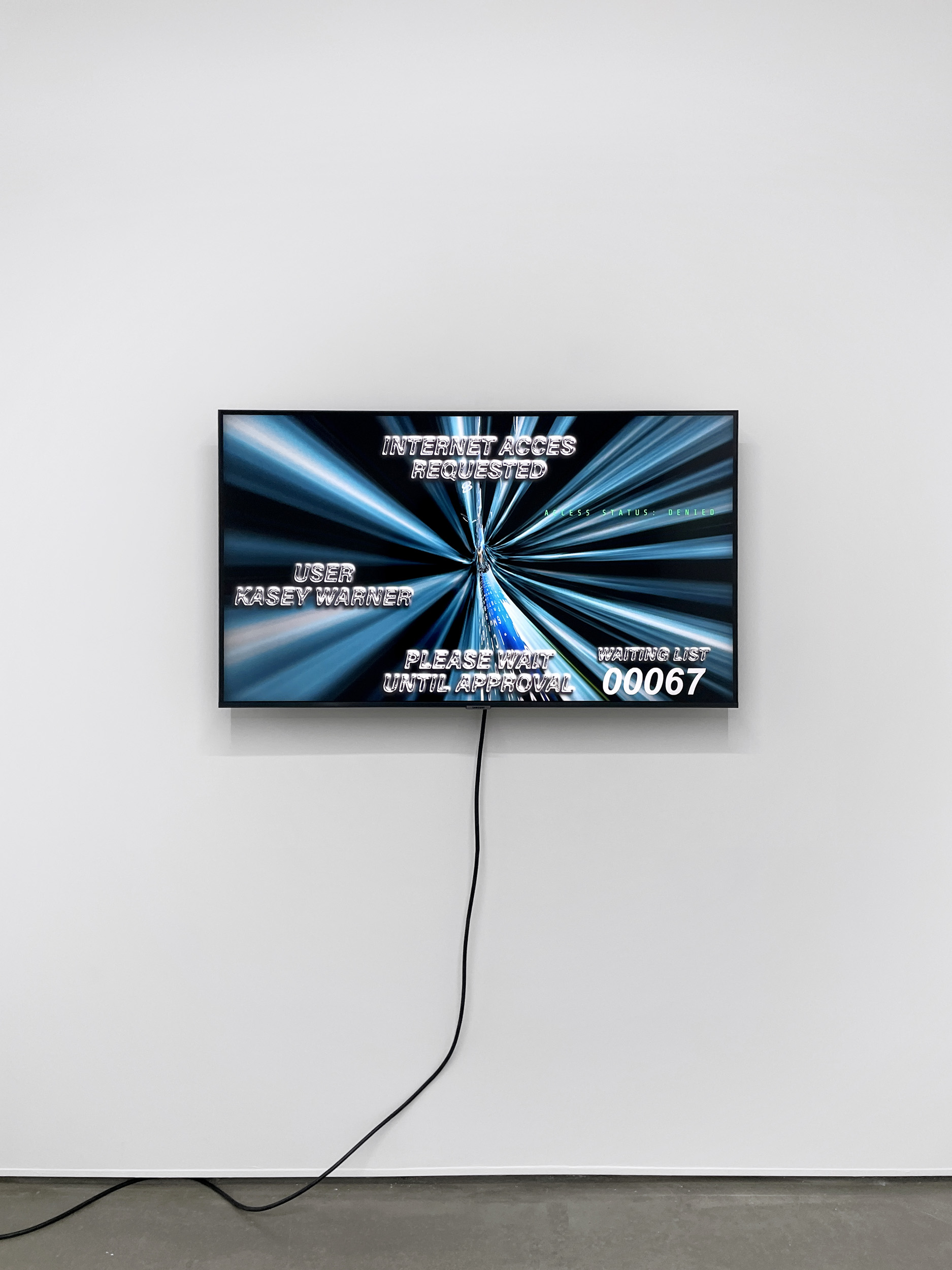 Lou Fauroux, The Internet Collapse series, Vol. 1 The Porn Selector, 2023
Lou Fauroux, The Internet Collapse series, Vol. 1 The Porn Selector, 2023Digital color film, stereo sound
17’00’’. Edition of 3
Inquire
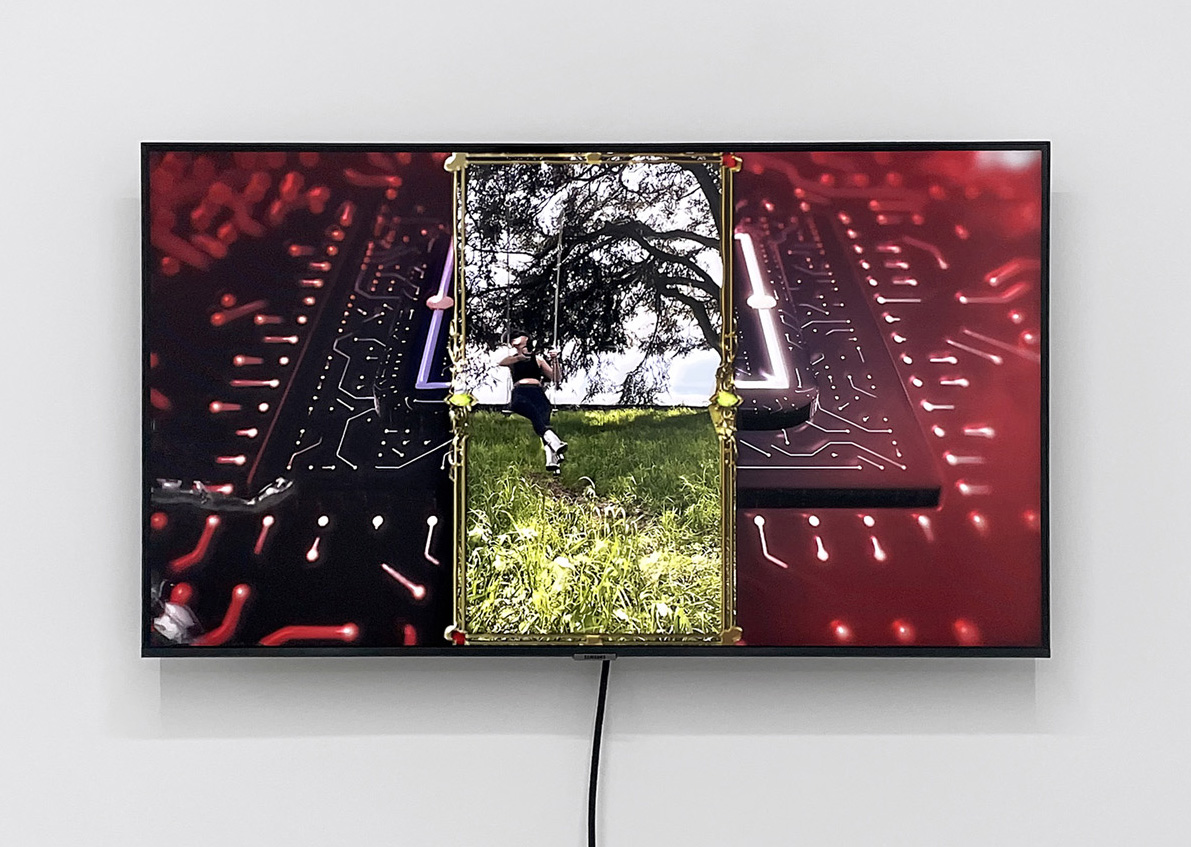 Lou Fauroux, The Internet Collapse series, Vol. 1 The Porn Selector, 2023
Lou Fauroux, The Internet Collapse series, Vol. 1 The Porn Selector, 2023Digital color film, stereo sound
17’00’’. Edition of 3
Inquire
 POV: you’re upset because it’s the end of the world and you’re stuck between realities, 2023
POV: you’re upset because it’s the end of the world and you’re stuck between realities, 2023Exo Exo, Paris
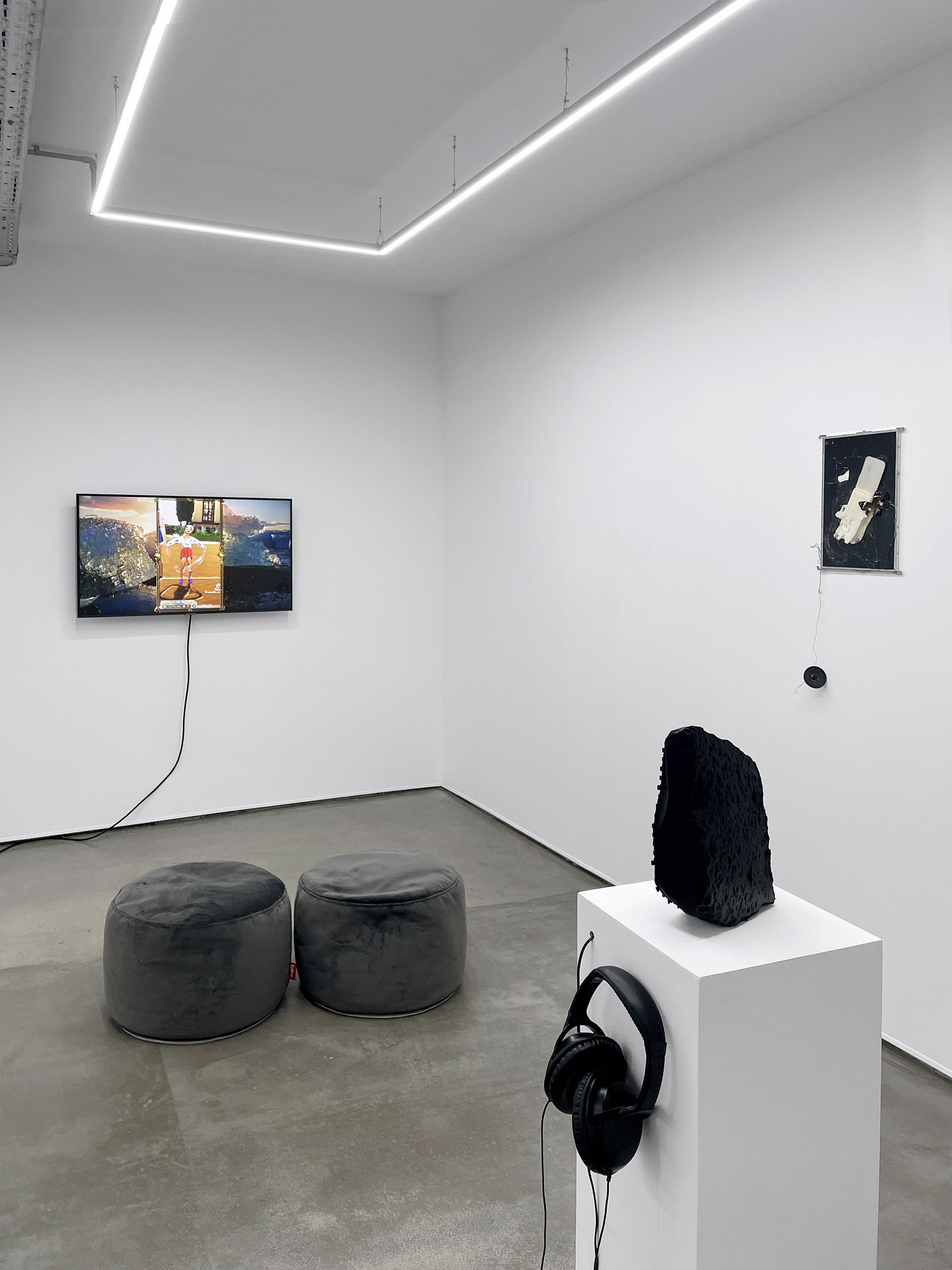 POV: you’re upset because it’s the end of the world and you’re stuck between realities, 2023
POV: you’re upset because it’s the end of the world and you’re stuck between realities, 2023Exo Exo, Paris
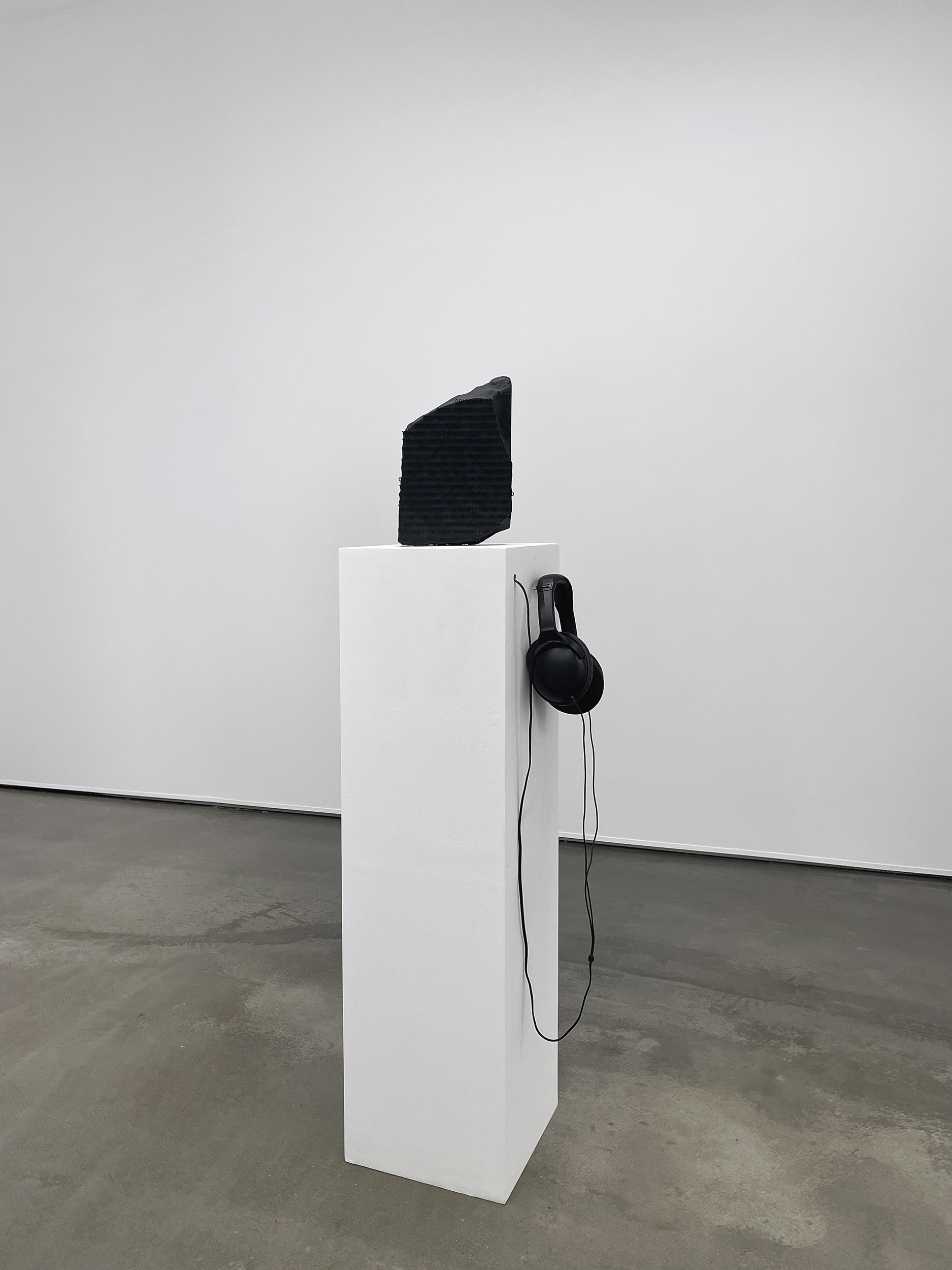 Lou Fauroux, What Remains, The Rosetta Stone B. (I want a dyke for president, credits Zoe Leonard), 2023
Lou Fauroux, What Remains, The Rosetta Stone B. (I want a dyke for president, credits Zoe Leonard), 20233D modeled PLA print
27 x 17 x 8 cm. Edition of 3
Inquire
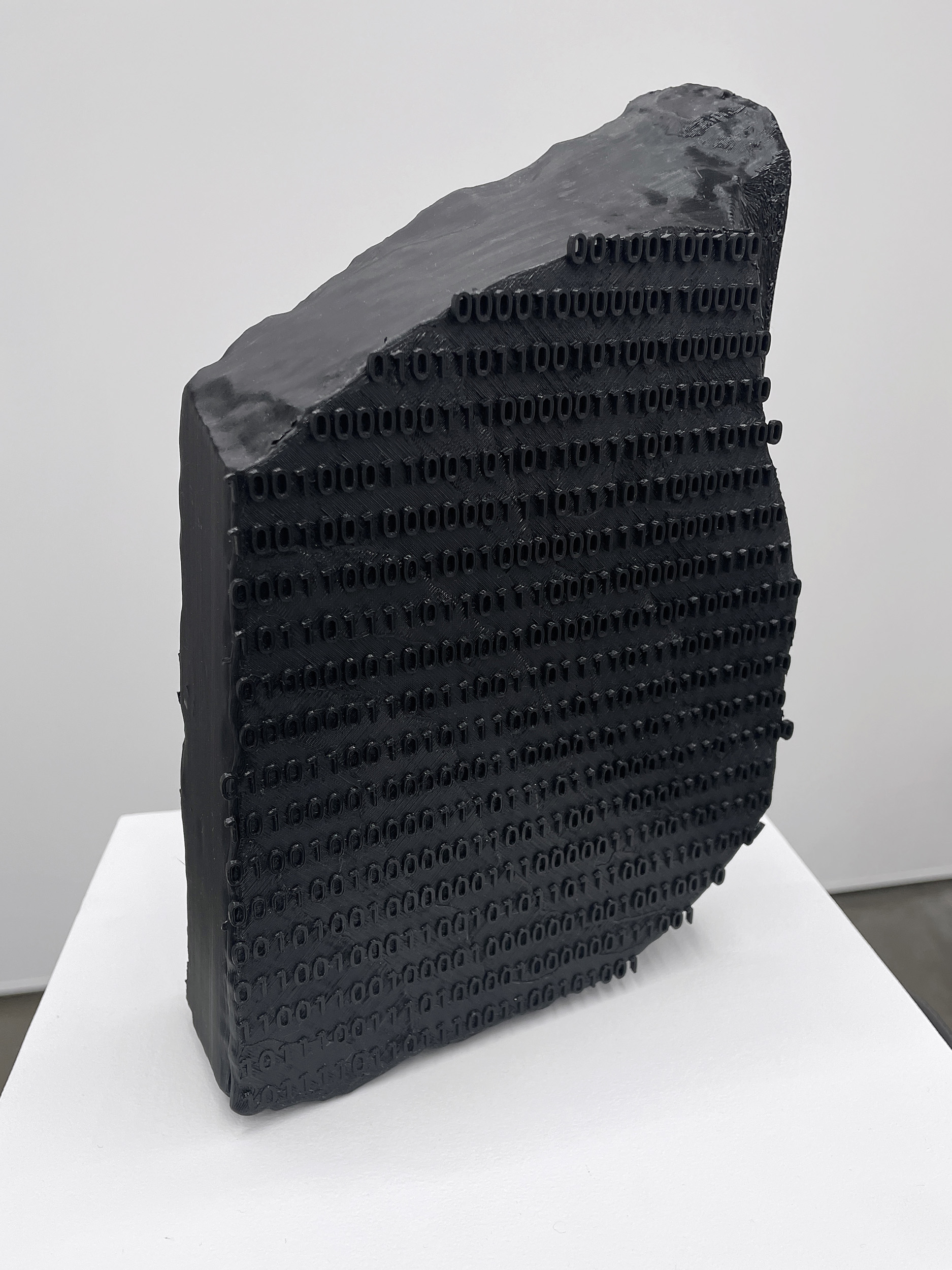 Lou Fauroux, What Remains, The Rosetta Stone B. (I want a dyke for president, credits Zoe Leonard), detail, 2023
Lou Fauroux, What Remains, The Rosetta Stone B. (I want a dyke for president, credits Zoe Leonard), detail, 20233D modeled PLA print
27 x 17 x 8 cm. Edition of 3
Inquire
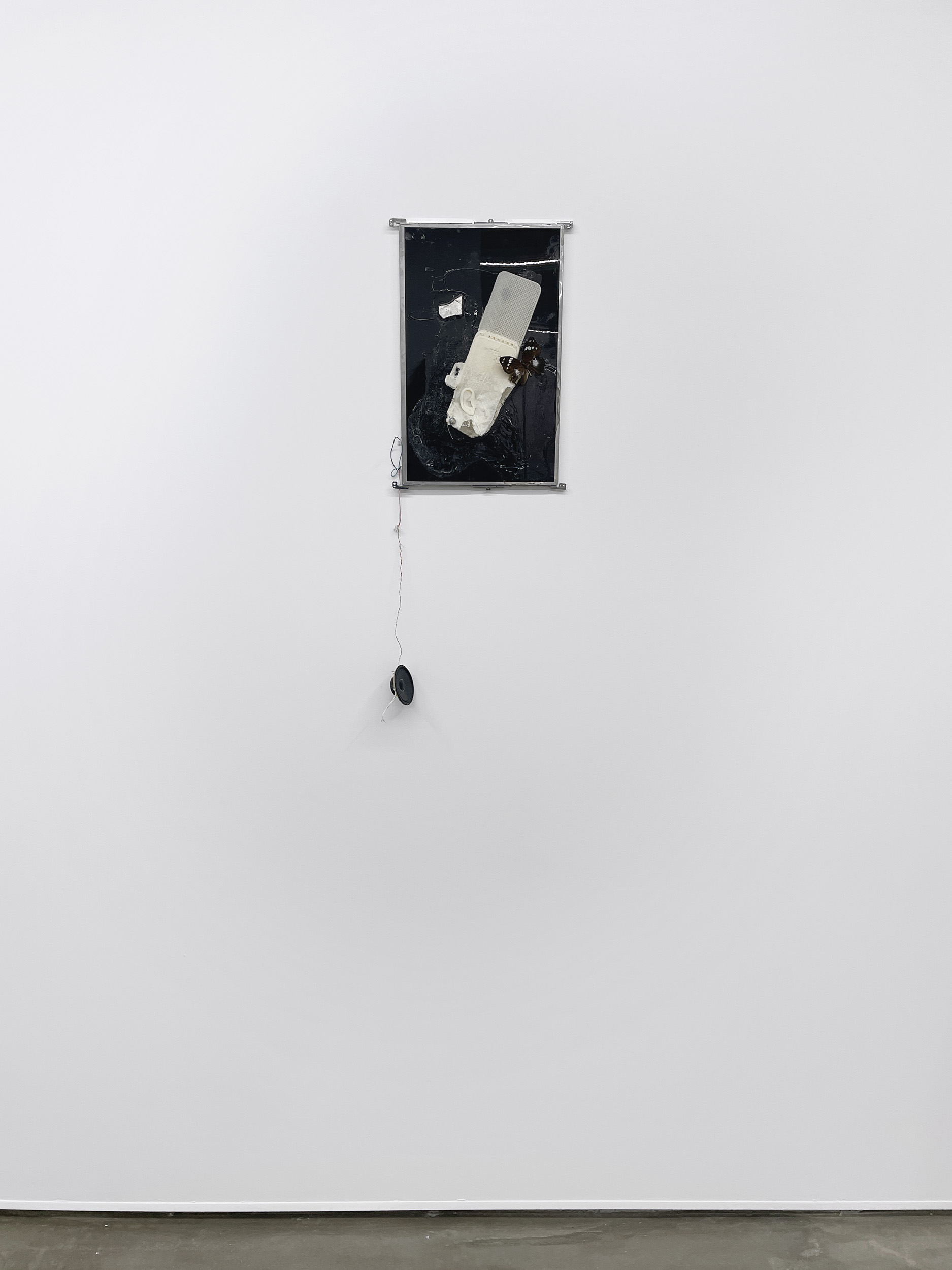 Lou Fauroux, Listen to your heart (The Butterfly Sanctuary series), 2023
Lou Fauroux, Listen to your heart (The Butterfly Sanctuary series), 2023Butterfly, resin, electric components
39,5 x 27,5 x 5 cm
Inquire
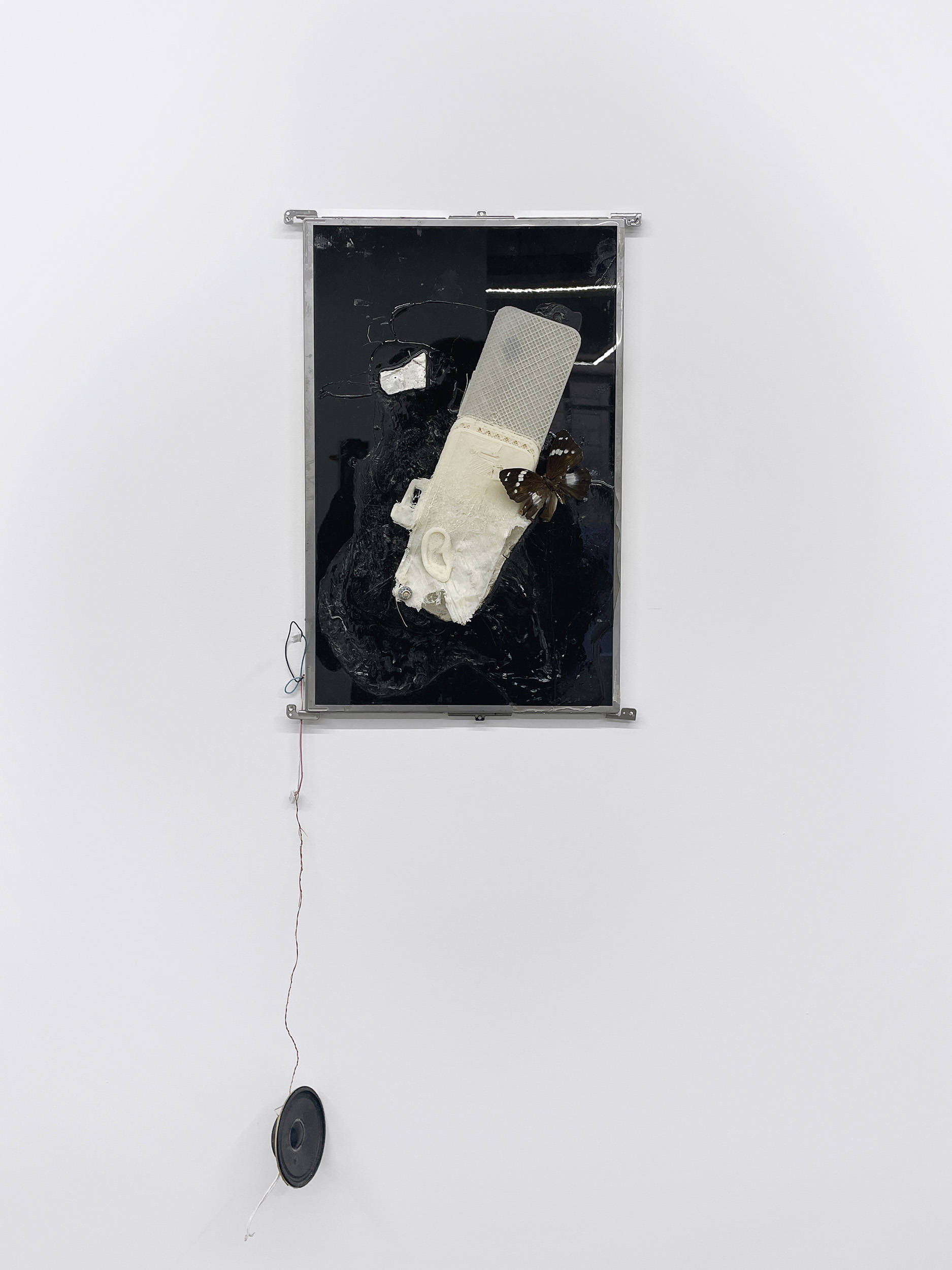 Lou Fauroux, Listen to your heart (The Butterfly Sanctuary series), detail, 2023
Lou Fauroux, Listen to your heart (The Butterfly Sanctuary series), detail, 2023Butterfly, resin, electric components
39,5 x 27,5 x 5 cm
Inquire
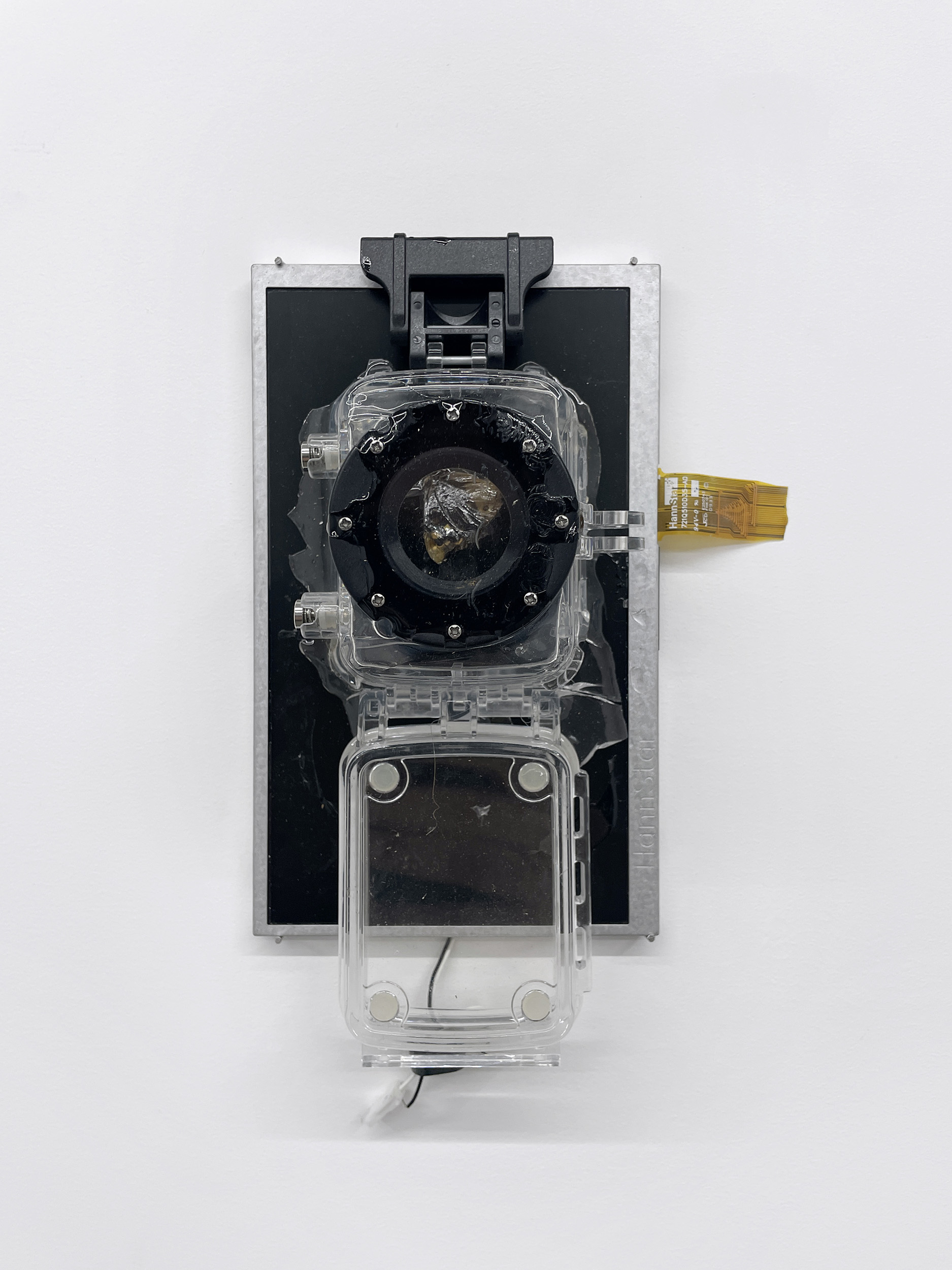 Lou Fauroux, The Lens Trap, 2023
Lou Fauroux, The Lens Trap, 2023Resin, electric components
16,5 x 10,5 x 6 cm
Inquire
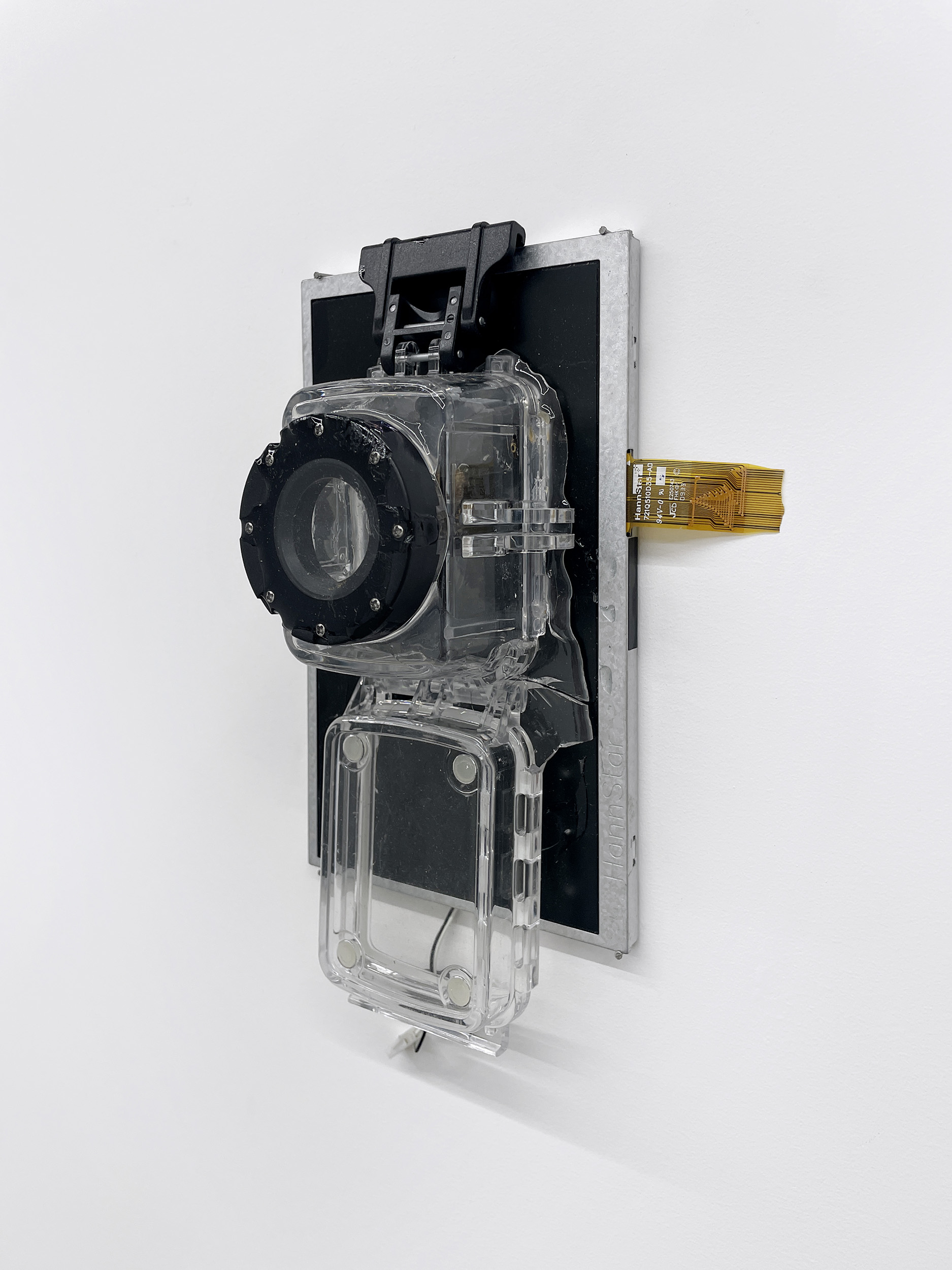 Lou Fauroux, The Lens Trap, 2023
Lou Fauroux, The Lens Trap, 2023Resin, electric components
16,5 x 10,5 x 6 cm
Inquire
*English below*
Comme j’ai été l’une des premières (et donc des seules pendant un temps) parmi les enfants de mon âge à avoir un téléphone et un ordinateur, je n’ai pas pu tout de suite m’en servir pour chatter online avec elleux. Mais en déménageant, j’ai quand même pu garder contact, alors que mes parents retrouvent encore leurs ami.e.s sur Copains d’Avant. Mon téléphone et mon ordinateur ont grandi avec moi, m’accompagnant de l’enfance, à l’adolescence jusqu’à l’âge adulte. Eux sont passés par différentes mises à jour. Ils ont changé et j’ai parfois eu du mal à les reconnaître, à être tolérante avec leur nouvelle manière de fonctionner et de se comporter avec moi. Ils me posent parfois des problèmes : ça m’énerve quand ça lag, ça m’énerve quand ça bug, ça m’énerve aussi quand ils me bombardent de notifications. Je pense qu’on a développé une vraie relation de co-dépendance. Ils sont accaparants et ils ont une peur de l’abandon évidente. Mais j’ai des ami.e.s comme ça aussi. Les gens disent qu’Internet et les réseaux sociaux c’est pourri. En même temps, j’ai appris à réparer mon chauffe-eau et à régler certains problèmes relationnels grâce à Reddit et Wikihow, à me fabriquer des vêtements grâce à Instagram et YouTube et à comprendre les règles de la belote contrée sur Wikipédia.
Mon téléphone m’angoisse autant qu’il m’écoute et me réconforte. J’essaye d’avoir du temps pour moi. Je ne sais pas si Internet, la suite Adobe et Microsoft, ChatGPT, TikTok, le correcteur automatique m’aident à en gagner. Je me demande comment les gens qui ont choisi d’autres extensions de Google Chrome que les miennes utilisent Internet. Est-ce que vous utilisez AdBlock ? Je ne sais pas dans quelle bulle de filtre je me situe, en tout cas, je sais que mon téléphone a compris que j’aimais les chiens. Avant, on parlait du cyberespace seulement dans la science-fiction, mais il occupe désormais toute une partie de notre réel. Le cyberespace c’est Twitter, Discord, Amazon, Twitch. On peut penser ce que l’on veut de ces technologies, du numérique, des jeux vidéo et des réseaux, ils.elles incarnent une réalité multiple à laquelle la fiction appartient et avec laquelle elles s’influencent, sont le prolongement l’une de l’autre. Être un humain, c’est avoir des outils et des instruments qui augmentent sa réalité. C’est imaginer et faire des rêves : une matière virtuelle qui traite du réel parce que finalement le ‘réel’ et le ‘virtuel’ sont difficilement distinguables l’un de l’autre.
Le magazine Errance, réalisé par Jeanne Yuna Rocher, fait ce lien par le traitement du shifting/daydreaming. Le shifting/daydreaming c’est le fait de passer d’une current reality à une desired reality, de déplacer sa conscience et son esprit d’une réalité à une autre. La virtualité n’est donc pas conditionnée par les écrans, elle se manifeste également mentalement. TikTok est la plateforme de prédilection des shifters qui y mettent en commun leur expérience de cette technique solitaire d’autohypnose. La salle d’attente dans laquelle on peut feuilleter le magazine est un espace liminal qui matérialise ce passage. Pour autant, le shifting est un phénomène psychologique ambigu qui se présente parfois par un décrochement inopiné de la current reality. La salle d’attente devient alors un lieu de rencontre entre individus montrant des symptômes similaires et en attente d’un diagnostic.
L’arrivée d’Internet s’accompagne ainsi de son lot de croyances et de mythologies alternatives. L’installation Dreams&Hopes de Montaine Jean évoquant la forme d’un autel rappelle que la technologie ne se départit pas de spiritualité. Internet devient un espace où l’on peut invoquer souhaits et prières. Inspirée de l’imaginaire de l’adolescence, l’installation présente une fenêtre de chambre ouverte sur un paysage appelant à la contemplation et à la rêverie. En fantasmant un ailleurs, l’esprit fait naître des désirs d’autonomie et d’individualité s’exprimant par des envies consommatrices. Les « gravoboi » (en référence au gourou d’une secte) font partie des « manifestations » qui sont ces petites formules magiques inscrites sous la forme de séries de chiffres. Elles expriment l’espoir de correspondre aux normes (le plus souvent de beauté) véhiculées dans les publicités des magazines (avoir de plus gros seins, perdre du poids, avoir des cuisses plus fines, etc.)
Faisant face, The World Wide Surveillance Board series, The SpaceX cemetery de Lou Fauroux rend compte d’un futur potentiel dans lequel il n’y aurait plus d’espace sur terre pour les morts, impliquant la création d’un cimetière céleste. Bien qu’elles soient riches de possibles, les outils du numérique s’inscrivent dans un contexte capitaliste et d’exploitation et sont avides d’énergie et de ressources minières. Est-il alors encore possible d’envisager une technologie émancipatrice dans un monde fatigué par l’appauvrissement de ses ressources ? L’artiste anticipe la fin d’Internet et l’obsolescence évidente des appareils et terminaux connectés avec The Internet Collapses series : VOL.1 The Porn Selector. Le film suit l’actrice Kasey Warner et sa tentative pour préserver son business porno suite à la mort d’Internet. Plus loin dans l’exposition, des restes et des vestiges où des organes humains se mélangent à des processeurs et batteries lithium témoignent de la chute de cette civilisation et du lien étroit unissant humanité et technologies. Appréhendant une archéologie du futur, Lou Fauroux dissémine des bribes de récits parfois explicitement queer à destination des prochaines entités vivantes pour influencer leurs imaginaires futurs.
– Camille Gouin
Jeanne Yuna Rocher (1999, Brest) est diplomée des Beaux-Arts de Marseille. Elle vit et travaille à Marseille. A la croisée des arts numériques, du film, de la sculpture et de l’édition, l’artiste travaille sur un espace domestique et intime immersif dans lequel sont examinés les rapports de pouvoir et de domination. Reprenant des formats typiques de la pop culture et de l’industrie audiovisuelle (téléréalité, interviews télévisées, métaverses, réseaux sociaux), l’artiste s’intéresse à la psychologie de l’individu seul et en groupe et à sa matérialisation dans des espaces virtuels et sur Internet. Les réseaux sociaux et autres plateformes numériques deviennent alors un lieu d’interactions entre les individus, de formation de communautés, de confrontation sociale, où s’exercent à la fois voyeurisme et isolement. Ils sont à la fois un territoire de fantasmes, de vies rêvées comme d’enfermement mental.
Montaine Jean (1995, Poitiers) est diplômée des Beaux-Arts de Marseille. Elle vit et travaille à Marseille. Son travail tisse des liens entre care et consommation. S’intéressant à tout ce qui vise à renforcer le bien-être de soi, notamment incarné dans l’apparence physique, reflet d’un état mental (« tu as bonne mine ! »), Montaine Jean interroge l’industrie cosmétique et son influence sur la construction de l’être et la formation de l’identité. Elle fait de la culture internet son prisme pour explorer la vie après la mort et la création des nouveaux rapports de consommation vécus comme désirs d’émancipation par les individus.
Lou Fauroux (1998, Mulhouse) a suivi des études à la HEAD et l’ECAL. Elle est diplômée de l'École nationale supérieure des Arts Décoratifs de Paris. Elle vit et travaille à Paris. Sa pratique vidéo et de l’installation se concentre sur les technologies du numérique, leurs interactions avec les humains et les usages actuels et futurs d’Internet tout en spéculant sur sa chute potentielle. Les narrations déployées dans ses films imprégnées de son expériencequeer tentent de réactualiser les images et représentations avec lesquelles elle a grandi. L’artiste y interroge les nouvelles formes du travail indexées sur le développement des nouvelles technologies et des réseaux sociaux. Elle y décortique les structures sociales du pouvoir qui s’appuient entre autres sur l’industrie du divertissement.
*
As I was one of the first (and therefore one of the only ones for a while) among kids my age to have a phone and a computer, I couldn't immediately use them to chat online with others. However, after moving, I could still keep in touch, while my parents continued to reconnect with their friends on Copains d'Avant. My phone and computer grew with me, accompanying me from childhood through adolescence to adulthood. They went through various updates, changing, and I sometimes struggled to recognize them, to be tolerant of their new ways of functioning and behaving with me. They sometimes cause me problems: it annoys me when there's lag, it annoys me when there are bugs, and it also annoys me when they bombard me with notifications. I think we've developed a true codependent relationship. They are demanding, and there's an obvious fear of abandonment. But I have friends like that too. People say that the Internet and social networks are rotten. At the same time, I learned to fix my water heater and resolve some relationship issues through Reddit and Wikihow, to make my own clothes through Instagram and YouTube, and to understand the rules of Belote Contrée on Wikipedia.
My phone stresses me out as much as it listens to me and comforts me. I try to make time for myself. I don't know if the Internet, the Adobe and Microsoft suites, ChatGPT, TikTok, and the autocorrect help me save time. I wonder how people who have chosen different Google Chrome extensions than mine use the Internet. Do you use AdBlock? I don't know in which filter bubble I find myself, but I know that my phone has figured out that I love dogs. Before, we only talked about cyberspace in science fiction, but it now occupies a whole part of our reality. Cyberspace is Twitter, Discord, Amazon, Twitch. One can think whatever they want about these technologies, digital, video games, and networks; they embody a multiple reality to which fiction belongs and with which they influence each other, an extension of one another. Being human is having tools and instruments that enhance your reality. It's about imagining and dreaming: a virtual substance that deals with the real because, in the end, 'real' and 'virtual' are hardly distinguishable from each other.
The magazine Errance, created by Jeanne Yuna Rocher, makes this connection through the treatment of shifting/daydreaming. Shifting/daydreaming is the act of moving from a current reality to a desired reality, shifting one's consciousness and mind from one reality to another. Virtuality is not only conditioned by screens; it also manifests mentally. TikTok is the platform of choice for shifters who share their experiences of this solitary self-hypnosis technique. The waiting room where one can flip through the magazine is a liminal space that materializes this passage. However, shifting is an ambiguous psychological phenomenon that sometimes presents itself as an unexpected detachment from the current reality. The waiting room then becomes a meeting place for individuals showing similar symptoms and awaiting a diagnosis.
The advent of the Internet thus comes with its share of alternative beliefs and mythologies. Montaine Jean's installation Dreams&Hopes, evoking the form of an altar, reminds us that technology does not rid itself of spirituality. The Internet becomes a space where one can invoke wishes and prayers. Inspired by the imagination of adolescence, the installation presents a bedroom window open to a landscape calling for contemplation and reverie. By fantasizing about elsewhere, the mind gives birth to desires for autonomy and individuality expressed through consumer desires. The "gravoboi" (referring to the guru of a sect) are part of the "manifestations" that are these small magical formulas inscribed in the form of series of numbers. They express the hope of conforming to the norms (most often of beauty) conveyed in magazine advertisements (having larger breasts, losing weight, having thinner thighs, etc).
Facing this, The World Wide Surveillance Board series, The SpaceX cemetery by Lou Fauroux depicts a potential future in which there would be no space on earth for the dead, implying the creation of a celestial cemetery. Although rich in possibilities, digital tools are embedded in a capitalist and exploitative context and are hungry for energy and mining resources. Is it still possible to envision emancipatory technology in a world tired by the depletion of its resources? The artist anticipates the end of the Internet and the obvious obsolescence of connected devices with The Internet Collapses series: VOL.1 The Porn Selector. The film follows the actress Kasey Warner and her attempt to preserve her porn business following the death of the Internet. Further into the exhibition, remains and relics where human organs mix with processors and lithium batteries testify to the fall of this civilization and the close link between humanity and technologies. Anticipating an archaeology of the future, Lou Fauroux scatters fragments of sometimes explicitly queer narratives for the next living entities to influence their future imaginaries.
– Camille Gouin
Jeanne Yuna Rocher (1999, Brest) graduated from the Beaux-Arts of Marseille. She lives and works in Marseille. At the intersection of digital arts, film, sculpture, and publishing, the artist works on an immersive domestic and intimate space examining power and domination relationships. Adopting formats typical of pop culture and the audiovisual industry (reality TV, television interviews, metaverses, social networks), the artist focuses on the psychology of the individual alone and in groups and its materialization in virtual spaces and on the Internet. Social networks and other digital platforms become places of interaction between individuals, the formation of communities, social confrontation, where both voyeurism and isolation are exercised. They are simultaneously a territory of fantasies, of dreamed lives, and of mental confinement.
Montaine Jean (1995, Poitiers) graduated from the Beaux-Arts of Marseille. She lives and works in Marseille. Her work weaves connections between care and consumption. Interested in everything aimed at enhancing self-well-being, especially embodied in physical appearance, a reflection of mental state ("you look good!"), Montaine Jean questions the cosmetic industry and its influence on the construction of being and the formation of identity. She uses internet culture as her prism to explore life after death and the creation of new consumption relationships experienced as desires for emancipation by individuals.
Lou Fauroux (1998, Mulhouse) studied at HEAD and ECAL. She graduated from l'École nationale supérieure des Arts Décoratifs de Paris. She lives and works in Paris. Her video and installation practice focuses on digital technologies, their interactions with humans, and the current and future uses of the Internet while speculating on its potential collapse. The narratives deployed in her films, influenced by her queer experience, attempt to update the images and representations she grew up with. The artist questions the new forms of work indexed on the development of new technologies and social networks. She dissects the social structures of power that rely, among other things, on the entertainment industry.